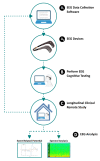Remote collection of electrophysiological data with brain wearables: opportunities and challenges
- PMID: 37340487
- PMCID: PMC10283168
- DOI: 10.1186/s42234-023-00114-5
Remote collection of electrophysiological data with brain wearables: opportunities and challenges
Abstract
Collection of electroencephalographic (EEG) data provides an opportunity to non-invasively study human brain plasticity, learning and the evolution of various neuropsychiatric disorders. Traditionally, due to sophisticated hardware, EEG studies have been largely limited to research centers which restrict both testing contexts and repeated longitudinal measures. The emergence of low-cost "wearable" EEG devices now provides the prospect of frequent and remote monitoring of the human brain for a variety of physiological and pathological brain states. In this manuscript, we survey evidence that EEG wearables provide high-quality data and review various software used for remote data collection. We then discuss the growing body of evidence supporting the feasibility of remote and longitudinal EEG data collection using wearables including a discussion of potential biomedical applications of these protocols. Lastly, we discuss some additional challenges needed for EEG wearable research to gain further widespread adoption.
Keywords: Diagnostics; Electroencephalography; Neuropathology; Remote medicine; Wearable devices.
© 2023. The Author(s).
Conflict of interest statement
The authors declare that they have no competing interests.
Figures





Similar articles
-
HEROIC: a platform for remote collection of electroencephalographic data using consumer-grade brain wearables.BMC Bioinformatics. 2024 Jul 18;25(1):243. doi: 10.1186/s12859-024-05865-9. BMC Bioinformatics. 2024. PMID: 39026153 Free PMC article.
-
Remote and Long-Term Self-Monitoring of Electroencephalographic and Noninvasive Measurable Variables at Home in Patients With Epilepsy (EEG@HOME): Protocol for an Observational Study.JMIR Res Protoc. 2021 Mar 19;10(3):e25309. doi: 10.2196/25309. JMIR Res Protoc. 2021. PMID: 33739290 Free PMC article.
-
Seizure Diaries and Forecasting With Wearables: Epilepsy Monitoring Outside the Clinic.Front Neurol. 2021 Jul 13;12:690404. doi: 10.3389/fneur.2021.690404. eCollection 2021. Front Neurol. 2021. PMID: 34326807 Free PMC article. Review.
-
General Practitioners' Perceptions of the Use of Wearable Electronic Health Monitoring Devices: Qualitative Analysis of Risks and Benefits.JMIR Mhealth Uhealth. 2021 Aug 9;9(8):e23896. doi: 10.2196/23896. JMIR Mhealth Uhealth. 2021. PMID: 34383684 Free PMC article.
-
Wearables in Sports Cardiology.Clin Sports Med. 2022 Jul;41(3):405-423. doi: 10.1016/j.csm.2022.02.004. Clin Sports Med. 2022. PMID: 35710269 Review.
Cited by
-
Naturalistic approach to investigate the neural correlates of a laundry cycle with and without fragrance.Biomed Opt Express. 2024 Aug 23;15(9):5461-5478. doi: 10.1364/BOE.528275. eCollection 2024 Sep 1. Biomed Opt Express. 2024. PMID: 39296381 Free PMC article.
-
A direct comparison of laboratory and community EEG recordings for neurodevelopmental research.Sci Rep. 2025 Jul 2;15(1):22671. doi: 10.1038/s41598-025-03569-5. Sci Rep. 2025. PMID: 40595834 Free PMC article.
-
HEROIC: a platform for remote collection of electroencephalographic data using consumer-grade brain wearables.BMC Bioinformatics. 2024 Jul 18;25(1):243. doi: 10.1186/s12859-024-05865-9. BMC Bioinformatics. 2024. PMID: 39026153 Free PMC article.
-
Remote Wearable Neuroimaging Devices for Health Monitoring and Neurophenotyping: A Scoping Review.Biomimetics (Basel). 2024 Apr 16;9(4):237. doi: 10.3390/biomimetics9040237. Biomimetics (Basel). 2024. PMID: 38667247 Free PMC article.
References
Publication types
Grants and funding
- Adam Coules Brain Tumour Research Grant/Adam Coules Brain Tumour Research Grant
- Terry Fox Foundation/Terry Fox Foundation
- Canadian Institute of Health Research/Canadian Institute of Health Research
- Brain Tumour Foundation of Canada/Brain Tumour Foundation of Canada
- Princess Margaret Cancer Foundation/Princess Margaret Cancer Foundation
LinkOut - more resources
Full Text Sources
